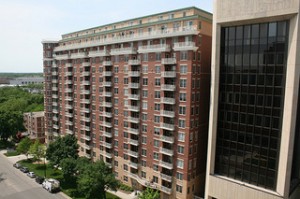Following my article in the Charlotte Observer last  Saturday, a developer contacted me regarding an FHA condominium approval for his mixed use condominium building. It is a 3-story building with 20 residential units on the top two floors. The first floor is commercial space.
Saturday, a developer contacted me regarding an FHA condominium approval for his mixed use condominium building. It is a 3-story building with 20 residential units on the top two floors. The first floor is commercial space.
FHA limits the amount of non-residential space to 25% of the total floor area. In addition, the non-commercial space must be homogenous with the residential space. Obviously, a rough estimate of the commercial space in this example is 33%, which exceeds the 25% guideline.
FHA does allow exceptions on a case-by-case basis for condominiums with non-residential space of more than 25% and up to 35%, and maybe even up to 50%. Such projects must be submitted to the Philadelphia Home Ownership Center regardless of its geographic location in the country. They may not be processed by a lender through the DELRAP system and have additional requirements to be met. FHA reserves the right to approve or reject exception requests.
The review process of exception requests is more subjective than for those with non-residential space of 25% or less. In addition, there are additional required documents that must be supplied including:
 A cover letter requesting consideration for an exception. The letter must include good cause reasons for requesting the exception, description of the usage of the floor area in the project by building and floor area and the percentage of non-residential space.
A cover letter requesting consideration for an exception. The letter must include good cause reasons for requesting the exception, description of the usage of the floor area in the project by building and floor area and the percentage of non-residential space.- An explanation on how the percentage of non-residential space was calculated, providing the calculations.
- A market analysis which much include a neighborhood analysis.
- Pictures of the project (both front and back) as well as the surrounding neighborhood – neighbors on all sides, street views and images from across the street.
- Spreadsheet that provides details about the non-residential units such as the owners’ names, lease terms, lessees’ names, types of businesses, monthly rents and current vacancies.
FHA goes on to say that the non-residential space must not have a negative impact on the residential character in the building(s) in which the residential units are located. It wants to know that a unit encumbered with FHA financing looks, feels and has the marketability of a residential unit.
FHA also wants to know that the residential units are “in control of their own destiny”. This basically means that the commercial units do not have an unfair advantage over the residential units in terms of the operation of the association or of the common elements. An example would be if the commercial units had a lower financial responsibility to the maintenance of the common elements, such as the parking, exterior or roof.
In this particular project, the residential units are responsible for the maintenance of the elevator which services only the top two floors of residential units. This would not be an example of the commercial units being given lower common charges because the elevator does not service the commercial units.
Basically, so long as the residential units appear to be residential in nature and have proportionate control of the association and the commercial units do not affect the marketability of the residential units and do not have an unfair advantage, the project is more than likely able to obtain an FHA condo approval. Obviously, this is notwithstanding the remaining criteria for condo project approval.
Info image courtesy of Stuart Miles/freedigitalphotos.net
Condominium photo credit: compujeramey via photopin cc






